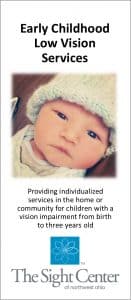Early Childhood Program
The Sight Center provides individualized services in the home or community for children with a vision impairment from birth to three years old.
Philosophy
The Early Intervention philosophy is that parents and caregivers are the most important teachers in a child’s life. Appropriate Early Intervention services foster meaningful bonds with children.
Purpose
Early Intervention assists a family in understanding the diagnosis, teach specific strategies to encourage their child’s development and help them gain the skills necessary for meeting the challenges of parenting a child with a visual impairment.
What To Expect
- Early Intervention for a child with a visual impairment under the age of three will begin with a review of medical records.
- An individualized assessment using a nationally recognized measure called The Oregon Project Skills Inventory will be completed. Results from this assessment are discussed with the family, caregivers and other service providers.
- A plan is created to address development in the areas of Cognitive, Fine Motor, Vision and Compensatory Skills.
- The Early Intervention Specialist suggests strategies for activities and provides encouragement to guide each family through the first three years of the child’s life.
- Our program focuses on helping a child learn to maximize use of remaining vision and to develop non-visual skills to increase independence in communication, play, movement and self-care.
Certified Staff
Our program is staffed by Certified Early Intervention Specialists with support from other Sight Center staff, including:
- Low Vision Optometrists
- Occupational Therapist
- Certified Orientation & Mobility Specialist
- Certified Vision Rehabilitation Therapist
- Social Work & Counseling Providers
Collaborations
The Sight Center of Northwest Ohio EI staff collaborate with other providers including Help Me Grow, local Boards of Developmental Disabilities, private therapists and physicians to provide a cohesive team approach to intervention to maximize the child’s progress toward individualized goals.
Possible Indications of a Vision Problem
If a child’s eyes…
- look cloudy or have unusual shape or size
- turn in, out, up or down or make jerky movements
If a child…
- looks through, rather than at people
- looks away to reach or reaches over/under objects
- tilts or turns his/her head to the side to look
- shows a preference of looking with one eye over the other
- is overly sensitive to bright light
- rubs or pokes his or her eyes

Take the Next Step
- Experience the Vision Impairment Simulator
- Find low vision solutions in The Shop Online
- Support our work with an online donation
- Follow us on Facebook
- Sign up for email updates
- Complete the Self-Referral Form
- Contact us if you need anything else
